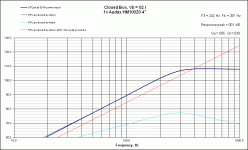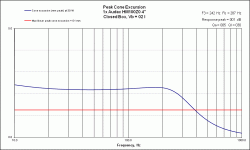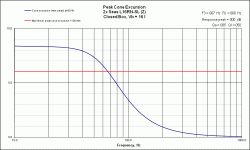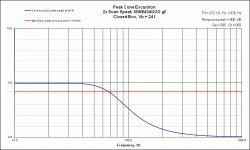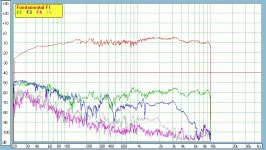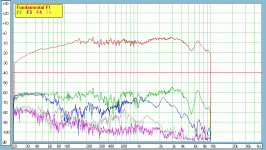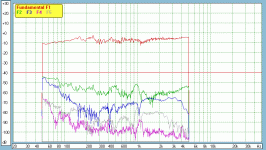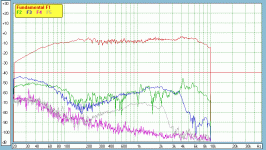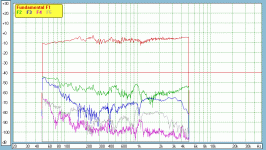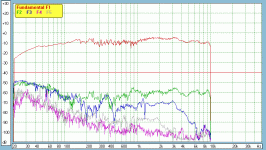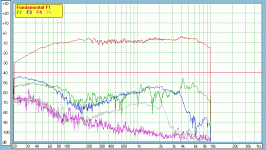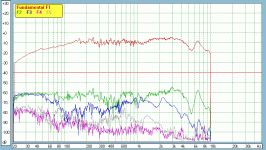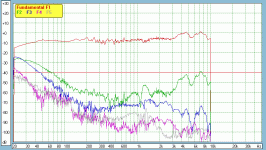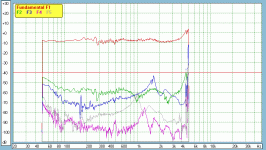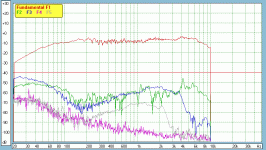Define the Project -
- Five speakers in a 5.0 system for both music and movies.
- Bookshelf Front with a single 6.5" bass driver in a 3-way configuration. Front Ported or Sealed; ie: no rear facing ports.
- Center Speaker - One or two 5" or 6.5" bass drivers, 3-way configuration. May or may not be ported, unknown at this point.
- Surround Speakers - 5" or 6.5" bass drivers (unknown), 2-way or 3-way (unknown), any special configuration (unknown), On-wall, in-wall, Di-pole/Bi-pole, on stands (unknown)
- Room size (unknown); Room dimensions (unknown); placement of equipment within the yet to be defined space (unknown)
By actually clearly defining the system, we see what we know and what we don't know.
As to the speaker literally being up against the wall, that is both unnecessary and unwise regardless of the placement of the ports. Most bookshelf speakers, depending on how much bass they have, need to be roughly 6" to 8" from the wall behind. In some cases 10" wouldn't hurt. Most floorstanding need to be 10" to 12" from the wall, and in some bass heavy speakers, 18" to 24" is necessary, though not for most speakers.
Only in the rarest of circumstance do speaker literally need to be against the wall, and even rear ported bookshelf don't need huge space behind them. If you get them any distance from the wall, they will mellow out and sound fine. Again, 6" to 10" for most bookshelf is sufficient, and achieving that is not as difficult as you have convinced yourself it is.
I had a pair of JBL Venue Stadium speakers with TWIN 8" woofers each in a 3.5-way system. Because the bass was already prominent, the speakers were just barely functional 12" from the wall with the rear ports plugged with Foam. I moved them to a new location, and with substantial room behind them, they settled down nicely, I was almost reluctant to sell them.
I generally find that as the speaker is closer to the wall, the bass increase, but it does so at the expense of mid-range clarity, which is something you don't want to sacrifice.
I've also found that literally right up against the wall is unnecessary. In my case, I move the speaker even with the front of my equipment cabinet, and that gives me the 10" to 12" I need for my floorstanding speakers. Many people have their speaker right along side the equipment cabinet, and are OK with the equipment cabinet reaching a certain distance into the room, but despite being side-by-side, they are not OK with the speakers being on the same front plane. I fail to see the logic.
So, with the limited (best guess) information we have, we assume -
- 6 woofers of various or the same size
- 3 or possibly 5 Mid-range Drivers
- 6 Tweeters
Given that you are having the cabinets and crossovers custom built, I would say 1/3rd to 1/2 of the budget would go to drivers. With a budget in the $3500 to $5000 range, that means you have between $1167 and $2500 for drivers.
Though you should probably stay in the £1200 to £1500 range. At least until you see what is possible. You need 17 drivers in the largest configuration, which means about $70 to $90 per driver. Though in reality, you can adjust individual drivers up or down as needed to fit the design. This just establishes perspective.
That should at least give you a frame of reference to get you started.
Now we have defined the problem. I would say the next step is to consider physical reality. Estimate the cabinet volume, figure out rough dimension, and see if you can actually get the drivers to fit in that box - woofer, mid-range, tweeter, plus port. Draw it up in a proportional sketch, and see the physical reality. Physical reality might dictate that the port has to be on the back. If you can make it work - fine, if not - then redesign.
Just a few thoughts.
Steve
- Five speakers in a 5.0 system for both music and movies.
- Bookshelf Front with a single 6.5" bass driver in a 3-way configuration. Front Ported or Sealed; ie: no rear facing ports.
- Center Speaker - One or two 5" or 6.5" bass drivers, 3-way configuration. May or may not be ported, unknown at this point.
- Surround Speakers - 5" or 6.5" bass drivers (unknown), 2-way or 3-way (unknown), any special configuration (unknown), On-wall, in-wall, Di-pole/Bi-pole, on stands (unknown)
- Room size (unknown); Room dimensions (unknown); placement of equipment within the yet to be defined space (unknown)
By actually clearly defining the system, we see what we know and what we don't know.
As to the speaker literally being up against the wall, that is both unnecessary and unwise regardless of the placement of the ports. Most bookshelf speakers, depending on how much bass they have, need to be roughly 6" to 8" from the wall behind. In some cases 10" wouldn't hurt. Most floorstanding need to be 10" to 12" from the wall, and in some bass heavy speakers, 18" to 24" is necessary, though not for most speakers.
Only in the rarest of circumstance do speaker literally need to be against the wall, and even rear ported bookshelf don't need huge space behind them. If you get them any distance from the wall, they will mellow out and sound fine. Again, 6" to 10" for most bookshelf is sufficient, and achieving that is not as difficult as you have convinced yourself it is.
I had a pair of JBL Venue Stadium speakers with TWIN 8" woofers each in a 3.5-way system. Because the bass was already prominent, the speakers were just barely functional 12" from the wall with the rear ports plugged with Foam. I moved them to a new location, and with substantial room behind them, they settled down nicely, I was almost reluctant to sell them.
I generally find that as the speaker is closer to the wall, the bass increase, but it does so at the expense of mid-range clarity, which is something you don't want to sacrifice.
I've also found that literally right up against the wall is unnecessary. In my case, I move the speaker even with the front of my equipment cabinet, and that gives me the 10" to 12" I need for my floorstanding speakers. Many people have their speaker right along side the equipment cabinet, and are OK with the equipment cabinet reaching a certain distance into the room, but despite being side-by-side, they are not OK with the speakers being on the same front plane. I fail to see the logic.
So, with the limited (best guess) information we have, we assume -
- 6 woofers of various or the same size
- 3 or possibly 5 Mid-range Drivers
- 6 Tweeters
Given that you are having the cabinets and crossovers custom built, I would say 1/3rd to 1/2 of the budget would go to drivers. With a budget in the $3500 to $5000 range, that means you have between $1167 and $2500 for drivers.
Though you should probably stay in the £1200 to £1500 range. At least until you see what is possible. You need 17 drivers in the largest configuration, which means about $70 to $90 per driver. Though in reality, you can adjust individual drivers up or down as needed to fit the design. This just establishes perspective.
That should at least give you a frame of reference to get you started.
Now we have defined the problem. I would say the next step is to consider physical reality. Estimate the cabinet volume, figure out rough dimension, and see if you can actually get the drivers to fit in that box - woofer, mid-range, tweeter, plus port. Draw it up in a proportional sketch, and see the physical reality. Physical reality might dictate that the port has to be on the back. If you can make it work - fine, if not - then redesign.
Just a few thoughts.
Steve
The only way that could really work is with an AT screen. Any other way and you'd have to raise the screen too high. I think the compromise of a well designed centre (hence all of this effort) will make for a better HT experience than having the screen a few feet higher than it should be.
Agreed, 100%
The Seas are really nice - I'm just a bit concerned about the sensitivity. 2 together just might do the trick.
Ok, let's talk sensitivity, xmax, xmechanical and max power input for a second.
Sensitivity = SPL with 1 watt at 1 meter at, I believe, 1000Hz.
So a driver with 86dB sensitivity does reach 105dB at about 75W (actually I took a guess, 79W is correct) at 1 meter and with no regards for amp headroom. Now move back from the front of that single speaker another 2 m and you're looking at about 95dB with those same 75W. I'm using this calculator Amplifier Power Required Calculator. Now, 95dB is LOUD. If you have an SPL meter, try playing with your volume control and measure from your listening position. For normal listening I don't need anything louder than 85-90dB and even that is loud (no capitals this time
xmax = the maximum distance (1 way) the voice coil travels within the gap. Outside the gap, magnetic forces decline, the cone is not controlled as well and distortion occurs.
x mechanical = the maximum physically distance the voice coil/cone can travel. Usually more than xmax but varies with the driver.
max power = the max wattage that the voice coil can electrically handle. Pretty straight forward.
Applying these to your choices, let's start with the Audax. Clearly, you want to keep distortion to a minimum, so you don't want to exceed xmax. First graph below shows the FR of the Audax in 2L with 30W. SPL at 1 m is 107.7dB. Left of the red line shows the frequencies at which xmax is exceeded. The limit here is the point at which the lines intersect, about 400Hz. Using a steep xo (3rd or 4th order) at 500Hz should hopefully diminish output below that point enough so that xmax is not exceeded. Second graph shows the same thing, peak excursion, in a different way - below the red line=good; above=bad. Again, point of intersection is about 400Hz.
So, this effectively limits your speaker to a max SPL of about 107dB at 1 m. Maybe 105 to be more on the safe side. Happily 30W is also below the Audax's max power of 40W. Of course if you move the xo up to say, 600Hz, that should allow a little bit more SPL. But if you also want to keep the xo at the baffle step point (not necessary, but helpful), now the baffle needs to be a little narrower- closer to 7.5" for 600Hz instead of 9" for 500Hz. And that makes a difference to your woofer selection.
Next graph is the cone excursion of 2 Seas in 16L, sealed with 76W and SPL of 106dB (1 m). xmax is exceeded at about 66Hz but it will be crossed at 80Hz so this is probably about your max SPL here with these. X mechanical though has an additional 5mm each way.
The 4th graph is 2 Discoveries in 24L, sealed with 38W and SPL of 106dB. Again, xmax is exceeded at about 66Hz. X mechanical has an extra 4mm.
So, the Seas and Discoveries look about the same in terms of max SPL. It's how you use your mid however that's going to limit how loud your speakers will go. But it's your woofer choice that's going to determine how much power your amps are going to need to get you there. And if you want some amp headroom for the peaks at this level then the advantage goes to the Discoveries. A 150W amp will have 3dB headroom with the Seas and 6dB of headroom with the Discoveries. The Scans will need a larger box though and the 9" wide baffle.
Have to go out right now but I have 2 more woofer suggestions to post later.
Attachments
Actually, just quickly here are 4 distortion measurements from Zaph. Three are 180mm drivers and 1 is a 15mm. Which would be your 1st choice from 80 to 500Hz?
Attachments
Wow - thanks for the effort and education!
Agreed, 100%
Ok, let's talk sensitivity, xmax, xmechanical and max power input for a second.
Sensitivity = SPL with 1 watt at 1 meter at, I believe, 1000Hz.
So a driver with 86dB sensitivity does reach 105dB at about 75W (actually I took a guess, 79W is correct) at 1 meter and with no regards for amp headroom. Now move back from the front of that single speaker another 2 m and you're looking at about 95dB with those same 75W. I'm using this calculator Amplifier Power Required Calculator. Now, 95dB is LOUD. If you have an SPL meter, try playing with your volume control and measure from your listening position. For normal listening I don't need anything louder than 85-90dB and even that is loud (no capitals this time).
xmax = the maximum distance (1 way) the voice coil travels within the gap. Outside the gap, magnetic forces decline, the cone is not controlled as well and distortion occurs.
x mechanical = the maximum physically distance the voice coil/cone can travel. Usually more than xmax but varies with the driver.
max power = the max wattage that the voice coil can electrically handle. Pretty straight forward.
Applying these to your choices, let's start with the Audax. Clearly, you want to keep distortion to a minimum, so you don't want to exceed xmax. First graph below shows the FR of the Audax in 2L with 30W. SPL at 1 m is 107.7dB. Left of the red line shows the frequencies at which xmax is exceeded. The limit here is the point at which the lines intersect, about 400Hz. Using a steep xo (3rd or 4th order) at 500Hz should hopefully diminish output below that point enough so that xmax is not exceeded. Second graph shows the same thing, peak excursion, in a different way - below the red line=good; above=bad. Again, point of intersection is about 400Hz.
So, this effectively limits your speaker to a max SPL of about 107dB at 1 m. Maybe 105 to be more on the safe side. Happily 30W is also below the Audax's max power of 40W. Of course if you move the xo up to say, 600Hz, that should allow a little bit more SPL. But if you also want to keep the xo at the baffle step point (not necessary, but helpful), now the baffle needs to be a little narrower- closer to 7.5" for 600Hz instead of 9" for 500Hz. And that makes a difference to your woofer selection.
Next graph is the cone excursion of 2 Seas in 16L, sealed with 76W and SPL of 106dB (1 m). xmax is exceeded at about 66Hz but it will be crossed at 80Hz so this is probably about your max SPL here with these. X mechanical though has an additional 5mm each way.
The 4th graph is 2 Discoveries in 24L, sealed with 38W and SPL of 106dB. Again, xmax is exceeded at about 66Hz. X mechanical has an extra 4mm.
So, the Seas and Discoveries look about the same in terms of max SPL. It's how you use your mid however that's going to limit how loud your speakers will go. But it's your woofer choice that's going to determine how much power your amps are going to need to get you there. And if you want some amp headroom for the peaks at this level then the advantage goes to the Discoveries. A 150W amp will have 3dB headroom with the Seas and 6dB of headroom with the Discoveries. The Scans will need a larger box though and the 9" wide baffle.
Have to go out right now but I have 2 more woofer suggestions to post later.
Here are some bits of random information that you might find helpful.
I did a test on my system to determine the volume difference between my CD and my Turntable; the CD was louder, but by how much?
For What It's Worth - LP vs CD SPL | AVForums.com - UK Online
With a 100w/ch amp and speakers with TWO 8" bass drivers each in a 3.5-way configuration, I was able to reach a 100dB average level at 1 o'clock on the volume dial. That is LOUD in my room, but not really straining the amp to excess. (See post #13 w/ photo of my system, only ONE set of speakers used during this test.)
Here are a few other threads that might be generally helpful. Mostly they relate to manufactured equipment, but the principles apply to any case were you are acquiring new equipment, whether bought or built.
Primer: How much do I have to spend to get a good System?
Primer: Acoustics - Absorption & Diffusion
Of more minor but still valuable interest -
Quality Dry Speaker Stand FILLER - CHEAP
Interactive Frequency and Sensitivity Charts
A discussion of exactly what constitutes Bass, Mid-Range, and Treble -
Bass, Midrange, and Treble? What?
Again, this is more general information stuff, but you might find it helpful in evaluating where you are going and what you are doing.
Here is another hand chart that shows the Power Distribution across the Frequency spectrum. For orchestral music, the peak power band is between 250hz and 500hz.
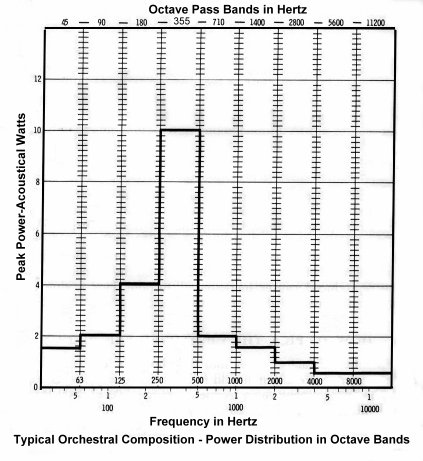
This can be a useful guide in determining relative power of various drivers, crossover points, and other useful things. Notice above 2000hz, you have 1/10th the power you have at 355hz.
I think you are getting good technical advice from others.
Steve
I did a test on my system to determine the volume difference between my CD and my Turntable; the CD was louder, but by how much?
For What It's Worth - LP vs CD SPL | AVForums.com - UK Online
With a 100w/ch amp and speakers with TWO 8" bass drivers each in a 3.5-way configuration, I was able to reach a 100dB average level at 1 o'clock on the volume dial. That is LOUD in my room, but not really straining the amp to excess. (See post #13 w/ photo of my system, only ONE set of speakers used during this test.)
Here are a few other threads that might be generally helpful. Mostly they relate to manufactured equipment, but the principles apply to any case were you are acquiring new equipment, whether bought or built.
Primer: How much do I have to spend to get a good System?
Primer: Acoustics - Absorption & Diffusion
Of more minor but still valuable interest -
Quality Dry Speaker Stand FILLER - CHEAP
Interactive Frequency and Sensitivity Charts
A discussion of exactly what constitutes Bass, Mid-Range, and Treble -
Bass, Midrange, and Treble? What?
Again, this is more general information stuff, but you might find it helpful in evaluating where you are going and what you are doing.
Here is another hand chart that shows the Power Distribution across the Frequency spectrum. For orchestral music, the peak power band is between 250hz and 500hz.

This can be a useful guide in determining relative power of various drivers, crossover points, and other useful things. Notice above 2000hz, you have 1/10th the power you have at 355hz.
I think you are getting good technical advice from others.
Steve
Last edited:
I generally find that as the speaker is closer to the wall, the bass increase, but it does so at the expense of mid-range clarity, which is something you don't want to sacrifice.
I'd agree with this. You either need to join a wall or move away from it. At the least you could use columns of absorbent beside the speakers against the wall or build wings onto the sides that chamfer toward the wall.
I'm going to preface this post by saying that I hesitate to rely solely upon harmonic distortion graphs but without hearing drivers personally, I don't think recommendations can be made without some kind of frame of reference. And so far people aren't jumping in with personal experiences re these drivers.
So in post #43, the graphs go like this: Scan Discovery 18W8434G, Scan Revelator 15W8530K00, Usher 8945A and Scan Revelator 18W8531G.
I posted the 15W8530K00 because that's my frame of reference. That's what I listen to from 80 - 2800Hz and can recommend almost unreservedly. My 1 caveat is that's it's only a 6" driver, so I find the LF (my guess is 80 - 200Hz) just a tiny little bit thin (I cross to a sub at 80), but a single cone with less than a 5" diameter can only push so much air. Otherwise, it's a superb driver as I mentioned before.
So looking at it's graph more closely, 3rd order distortion stays below -70 from about 150 to 1200Hz. Fifth order almost mirrors this a little lower but with a bump at 120 - 200Hz. Second order is higher but is considered more benign.
Looking at the 7" Revelator, its graphs have always confused me a little. Everyone raves about its sound (well, almost everyone), yet below 200Hz its 2nd order distortion does not stay below -70. I've heard it said that we don't hear distortion in the LF quite as well, so maybe this has something to do with it. Or perhaps it's everything taken as whole. Or perhaps it's over-hyped.
In terms of the Discovery, 3rd order is only below -70 from about 125 to 350Hz altho 2nd order is also nice and low in the 150 - 700Hz range. Rick, for your purposes, I'm now thinking this is inadequate. This fails to meet the benchmark I'm trying to set with my 15W's.
So, another ScanSpeak that is well regarded is the 18W8545K http://www.solen.ca/pdf/scan/18w8545k.pdf, $172 at Solen but they only have 2 in right now. Also, sorry no distortion measurements. Sensitivity is 87dB.
However, the Usher 8945A is virtually the exact same driver for $125 (that is from the States tho so it'll cost us a little more) Usher 8945A 7" Carbon Fiber/Paper Woofer 296-600. Not sure if that's getting too expensive for you but it might be the best 180mm performer I've found from 80 to 800Hz. Sensitivity of 2 in parallel after 4dB BSC will be about 88dB and 2 of them sealed in 13L, Qtc of .703 gives an f3 of 75Hz and max SPL of 110dB. Third order distortion stays below -70 from about 80 to 800 Hz, 2nd order below -60 all across the FR and now that's better than my 15W's. So according to my criteria, highly, highly recommended.
Lastly, here's the SB Acoustics 17MFC35-8, $64 http://www.solen.ca/pdf/sb/sb17mfc358.pdf. I really like what this company is doing. Value is amazing. Sensitivity of 2 in parallel after 4dB BSC will be about 89dB and 2 of them sealed in 18L, Qtc of .702 gives an f3 of 70Hz and max SPL of 107dB. Third order distortion stays below -70 from about 160 to 1200 Hz, which is about exactly the same as my 15W but also with lower 2nd order all across the usable range. Totally comparable to my 15W's but just a little poorer distortion in the bottom octave, 80 to 160 Hz. But value is hard to beat. And good sensitivity. Driver width is also only 171mm. SB makes the Satori too btw, which I highly recommended before but isn't really good for your application. Quality trickle down and all that.....
You might also want to think of this. If your surrounds are much closer to you than your front channels, you may just be able to get away with a single woofer in these. Same timbre but they just won't play quite as loud which they may not need to. That could save you a couple of hundred bucks, altho the way I look at these things is in the long run, a couple of hundred bucks really doesn't matter over the life span of the speakers.
Maybe some others can comment on any of these selections too.
Graphs: Rev15W, Rev18W, Scan Discovery, Usher 8945A, Usher 17MFC35-8
So in post #43, the graphs go like this: Scan Discovery 18W8434G, Scan Revelator 15W8530K00, Usher 8945A and Scan Revelator 18W8531G.
I posted the 15W8530K00 because that's my frame of reference. That's what I listen to from 80 - 2800Hz and can recommend almost unreservedly. My 1 caveat is that's it's only a 6" driver, so I find the LF (my guess is 80 - 200Hz) just a tiny little bit thin (I cross to a sub at 80), but a single cone with less than a 5" diameter can only push so much air. Otherwise, it's a superb driver as I mentioned before.
So looking at it's graph more closely, 3rd order distortion stays below -70 from about 150 to 1200Hz. Fifth order almost mirrors this a little lower but with a bump at 120 - 200Hz. Second order is higher but is considered more benign.
Looking at the 7" Revelator, its graphs have always confused me a little. Everyone raves about its sound (well, almost everyone), yet below 200Hz its 2nd order distortion does not stay below -70. I've heard it said that we don't hear distortion in the LF quite as well, so maybe this has something to do with it. Or perhaps it's everything taken as whole. Or perhaps it's over-hyped.
In terms of the Discovery, 3rd order is only below -70 from about 125 to 350Hz altho 2nd order is also nice and low in the 150 - 700Hz range. Rick, for your purposes, I'm now thinking this is inadequate. This fails to meet the benchmark I'm trying to set with my 15W's.
So, another ScanSpeak that is well regarded is the 18W8545K http://www.solen.ca/pdf/scan/18w8545k.pdf, $172 at Solen but they only have 2 in right now. Also, sorry no distortion measurements. Sensitivity is 87dB.
However, the Usher 8945A is virtually the exact same driver for $125 (that is from the States tho so it'll cost us a little more) Usher 8945A 7" Carbon Fiber/Paper Woofer 296-600. Not sure if that's getting too expensive for you but it might be the best 180mm performer I've found from 80 to 800Hz. Sensitivity of 2 in parallel after 4dB BSC will be about 88dB and 2 of them sealed in 13L, Qtc of .703 gives an f3 of 75Hz and max SPL of 110dB. Third order distortion stays below -70 from about 80 to 800 Hz, 2nd order below -60 all across the FR and now that's better than my 15W's. So according to my criteria, highly, highly recommended.
Lastly, here's the SB Acoustics 17MFC35-8, $64 http://www.solen.ca/pdf/sb/sb17mfc358.pdf. I really like what this company is doing. Value is amazing. Sensitivity of 2 in parallel after 4dB BSC will be about 89dB and 2 of them sealed in 18L, Qtc of .702 gives an f3 of 70Hz and max SPL of 107dB. Third order distortion stays below -70 from about 160 to 1200 Hz, which is about exactly the same as my 15W but also with lower 2nd order all across the usable range. Totally comparable to my 15W's but just a little poorer distortion in the bottom octave, 80 to 160 Hz. But value is hard to beat. And good sensitivity. Driver width is also only 171mm. SB makes the Satori too btw, which I highly recommended before but isn't really good for your application. Quality trickle down and all that.....
You might also want to think of this. If your surrounds are much closer to you than your front channels, you may just be able to get away with a single woofer in these. Same timbre but they just won't play quite as loud which they may not need to. That could save you a couple of hundred bucks, altho the way I look at these things is in the long run, a couple of hundred bucks really doesn't matter over the life span of the speakers.
Maybe some others can comment on any of these selections too.
Graphs: Rev15W, Rev18W, Scan Discovery, Usher 8945A, Usher 17MFC35-8
Attachments
Thanks for all of the comments there. Where does the L16 fit in there?
And with the Seas, I'm trying to understand the difference between L16RN-SL and L16RNX.
I'd always been thinking a single woofer for the rears. That's had me thinking an 8ohm for the fronts (two in parallel giving 4 ohms) and a 4ohm for the rears (typically higher sensitivity) so that the mid and tweeter aren't excessively padded in the rears.
Talking about padding - does it impact power handling?
With the Audax mid, it has 93db sensitivity, which if the woofers end up at 88db would need a lot of padding. Although, there is the C0 model (as opposed to the Z0) which is under the 4" woofers at Madisound instead of 4" midrange, and it shows lower sensitivity (so less padding).
And with the Seas, I'm trying to understand the difference between L16RN-SL and L16RNX.
You might also want to think of this. If your surrounds are much closer to you than your front channels, you may just be able to get away with a single woofer in these. Same timbre but they just won't play quite as loud which they may not need to. That could save you a couple of hundred bucks, altho the way I look at these things is in the long run, a couple of hundred bucks really doesn't matter over the life span of the speakers.
I'd always been thinking a single woofer for the rears. That's had me thinking an 8ohm for the fronts (two in parallel giving 4 ohms) and a 4ohm for the rears (typically higher sensitivity) so that the mid and tweeter aren't excessively padded in the rears.
Talking about padding - does it impact power handling?
With the Audax mid, it has 93db sensitivity, which if the woofers end up at 88db would need a lot of padding. Although, there is the C0 model (as opposed to the Z0) which is under the 4" woofers at Madisound instead of 4" midrange, and it shows lower sensitivity (so less padding).
Sorry, the L16 and Discovery distortion responses are very, very similar so I just posted the 1, but I guess the Seas might have very slightly better 3rd and 5th distortion from 80 to 500Hz. Advantage in 2nd order goes to the Scan. Graphs below: Seas then Scan. Again, not having heard these I'm trying to find a driver with similar measurements to what I have heard and can recommend. Both of these are close but fall short of the Scan 15W.Thanks for all of the comments there. Where does the L16 fit in there?
L16RN is good in both ported or sealed. L16RNX is designed to work better in smaller, ported boxes. (Man, I so want to get you into something like Unibox. You'll learn so much thru the process of playing around with all of this stuff.)And with the Seas, I'm trying to understand the difference between L16RN-SL and L16RNX.
So, the RN hits 67Hz in 8L with heavy stuffing (not absolutely necessary, but my preference). The RNX-8 hits 78Hz in 5.4L but only if you stuff it lightly. The RNX-4 only hits 86Hz in 8L with light stuffing. All boxes sealed with Qtc close to .7 (which is desirable). RNX-4 will go lower ported in about 8L.
That's a good idea. I hadn't thought of that. But I would think that for what you are looking for, sound quality would be the 1st priority. Still, all drivers mentioned so far except the Usher also come in 4ohms..... and a 4ohm for the rears (typically higher sensitivity) so that the mid and tweeter aren't excessively padded in the rears.
Quick answer is no - power handling of the driver stays unchanged. The resistors just eat up a certain percentage of the power before it hits the driver and so it doesn't play as loud until you feed it more watts. Tweeters and mids in 3-ways are padded down all the time, sometimes quite a lot. I think the sensitivity of my speakers is about 82dB which means the tweeter is padded down about 10dB. Again, it just becomes a consideration of how loud you want them to play and how much power you have to play with. Altho, I'm a very practical kind of person and I hate to waste things so I'm with you in trying to keep the sensitivity high. But it wouldn't be my 1st priority.Talking about padding - does it impact power handling?
With the Audax mid, it has 93db sensitivity, which if the woofers end up at 88db would need a lot of padding. Although, there is the C0 model (as opposed to the Z0) which is under the 4" woofers at Madisound instead of 4" midrange, and it shows lower sensitivity (so less padding).
Actually, now that I think about it, there are 2 advantages to higher sensitivity. Less power in the voice coil means good electrical things like less heat generated and other stuff that's beyond me. And the cone also has to move less for a given SPL which means less inter-modulation distortion. Very subtle again so good if achievable but still not my 1st priority.
Also, stick with the Aerogel cone. To my knowledge it's got more magic in it for the midrange than the carbon fibre. Moving mass 25g vs 69g for example.
Attachments
Man, I so want to get you into something like Unibox. You'll learn so much thru the process of playing around with all of this stuff.
That could be a next step - but not for a couple of weeks (studying hard for a wine exam, and too much work to do in my software company - sigh).
Whether you can use 4 ohms speakers depends on your AV Receiver. Likely if it is a Sony, then not. If it is a Yamaha, then maybe.
Also, are you thinking of making the Front Left/Right in an W(MT)W configuration to match the Center, or was the 4 ohms a reference to just the Center alone?
If you wire in series, the speaker pair will handle twice the power and produce the same sound with half the excursion. Less excursion means less distortion. In terms of output, two in series put out as much as one speaker, but like I said, more power handling and less excursion for less distortion.
In parallel, you get higher output, but that is offset with a fixed excursion, which is offset by lower impedance. If you have a good quality AV amp that is 4 ohm rated, especially if it is only one 4 ohm Center speakers, you won't have a problem.
But these are the circumstance driven aspects that need to be considered. Even though you are building speakers, you need to consider them in the context of the full system including the room size.
There is no real right or wrong, there are only choices that serve the goal, and exist within the boundaries of your particular circumstances.
As to Seas speakers, I will point out that many commercial high quality hi-fi speaker are built around Seas drivers. Take XTZ of Sweden. Excellent sounding speaker based around, for the most part, Seas drivers.
As further suggestions consider -
- Morel
- Aurum Cantus
- higher end Hi-Vi
- Scanspeak
Possibly -
- Usher
Though there are certainly others.
Steve
Also, are you thinking of making the Front Left/Right in an W(MT)W configuration to match the Center, or was the 4 ohms a reference to just the Center alone?
If you wire in series, the speaker pair will handle twice the power and produce the same sound with half the excursion. Less excursion means less distortion. In terms of output, two in series put out as much as one speaker, but like I said, more power handling and less excursion for less distortion.
In parallel, you get higher output, but that is offset with a fixed excursion, which is offset by lower impedance. If you have a good quality AV amp that is 4 ohm rated, especially if it is only one 4 ohm Center speakers, you won't have a problem.
But these are the circumstance driven aspects that need to be considered. Even though you are building speakers, you need to consider them in the context of the full system including the room size.
There is no real right or wrong, there are only choices that serve the goal, and exist within the boundaries of your particular circumstances.
As to Seas speakers, I will point out that many commercial high quality hi-fi speaker are built around Seas drivers. Take XTZ of Sweden. Excellent sounding speaker based around, for the most part, Seas drivers.
As further suggestions consider -
- Morel
- Aurum Cantus
- higher end Hi-Vi
- Scanspeak
Possibly -
- Usher
Though there are certainly others.
Steve
Whether you can use 4 ohms speakers depends on your AV Receiver. Likely if it is a Sony, then not. If it is a Yamaha, then maybe.
Also, are you thinking of making the Front Left/Right in an W(MT)W configuration to match the Center, or was the 4 ohms a reference to just the Center alone?
The plan is the front three will all have two woofers (making them each 4 ohm). The rear two will only have one woofer, so getting a 4ohm version of the one used in the front will result in closer overall sensitivity and similar xo design.
I currently have an Arcam P1000 as my amp. If in the end the speaker sensitivity dictates more power then I will replace the amp. In any case, it will be able to deal with 4ohm loads.
I think you are worrying too much about Sensitivity or output. The difference is very small and the AV Amp is more than able to make up the difference by balancing the output of the speakers. With an quality ARCAM amp, I don't think you are going to have any problems with low impedance.
More important is that they use the same components, and that the crossovers are very similar.
Can we assume the Surround Speakers will be 2-way? That is probably all your really need, but your choice.
As to the rear speakers, I see no need that they be 4 ohm. Other can weigh in with more authority on that, but I see no point to it. The front and center based on the design pretty much have to be 4 ohms.
However, two 4 ohms drivers in Series has its own set of advantages. Weigh them both and see which best serves your goals.
Again, no right or wrong, there are only the goals and objectives with the context of the circumstances.
Given the advise others are giving you, it looks like you are heading to some great speakers.
Steve
More important is that they use the same components, and that the crossovers are very similar.
Can we assume the Surround Speakers will be 2-way? That is probably all your really need, but your choice.
As to the rear speakers, I see no need that they be 4 ohm. Other can weigh in with more authority on that, but I see no point to it. The front and center based on the design pretty much have to be 4 ohms.
However, two 4 ohms drivers in Series has its own set of advantages. Weigh them both and see which best serves your goals.
Again, no right or wrong, there are only the goals and objectives with the context of the circumstances.
Given the advise others are giving you, it looks like you are heading to some great speakers.
Steve
Last edited:
Also, what did you think of the cost analysis I did?
If we assume an average of $75 to $100 per driver, that is a total of about $300 to $400 per 2x bass 3-way speakers. But we would probably not balance the money in an equal fashion.
I would say about 50% to 60% for the bass drivers, about 30% for the Midrange, and about 15% for the Tweeter.
Which is about $150 to $180 for the twin bass drivers ($75 to $90 each), about $90 to $120 for the Mid-Range, and about $45 to $60 for the tweeter.
This is not remotely etched in stone, there is plenty of room to deviate based on the appeal of actual components you find. But I think you need to do a cost analysis to understand how much money needs to go where. I see people recommending, unless I'm mistaken, bass drivers approaching $200 each. Using my ratios, that breaks down into about $700 per 3-way speaker for Driver components alone. Is that consistent with your budget?
If you can get some estimate of the Cabinet and Crossover build, then subtract that from your total budget, you can get some sense of what is available for components, then you break that down into a reasonable balance between the various drivers. I would suggest you leave about 20% to 25% of your planned budget for unexpected MISC expenses.
I'm trying to get you to break the project down in a structured fashion, I think we were more than half way through this thread before we even realized you were talking about a Center speaker, then a few more posts beyond that before we even realized you were planning to build a 5.0 AV system.
The better you can define the project for yourself and for us, the more focused we can be in our responses.
How much do you see yourself spending per driver; per 3-way speaker box for each Driver?
Then what is the balance among those drivers - 1:1:1? Or as I suggested 55:30:15? Or some other ratio of the cost of the 2xBass:Mid-Range:Tweeter?
Now, if you ask the question, those here can help you establish realistic balances between components, but it is hard to answer a question that hasn't been asked.
Once we have that, we can focus responses in the working range you've set. Though again, these numbers only establish perspective and give you a starting point. There is plenty of room to adjust the ratios and prices based on the components you actually find.
Once again, I am speaking more generally, and less technically than others who are responding. But I find, in general, you get the best and most productive responses if you provide the best possible framework within which those responses can come.
Break down your budget, find out the estimates on the cabinets and the crossovers, set aside a fair amount for MISC, then break the balance down per speaker, then per driver. How much, withing a working range, do you think you can spend on the woofers, the midrange, the tweeters? What is the balance of those components? Are they all the same price - $100 per woofer, $100 per midrange, $100 per tweeter ($400 total), or is it better to spend more on the woofer and less on the midrange/tweeter, or it it better to spend more on the midrange/tweeter and less on the woofer.
I think before you can realistically start picking random components, you need to do this break down of the budget, and get a realistic sense of the cost of each driver. From that, you can determine the components.
I think a more structured step-by-step approach will yield more productive results.
Perhaps I am misguided, perhaps at this point you don't want to refine it that much. Perhaps, you simply want to discuss the possibilities, then you will adjust the budget to meet interesting component you find.
However, in my view, the more tightly and clearly the problem is analyzed, defined, and laid out, the more productive and useful the responses will be.
Pardon me for saying so ... again ...
"You can't find what you are looking for until you know what you are looking for."
But then ... that's just my broad and general opinion.
Steve
If we assume an average of $75 to $100 per driver, that is a total of about $300 to $400 per 2x bass 3-way speakers. But we would probably not balance the money in an equal fashion.
I would say about 50% to 60% for the bass drivers, about 30% for the Midrange, and about 15% for the Tweeter.
Which is about $150 to $180 for the twin bass drivers ($75 to $90 each), about $90 to $120 for the Mid-Range, and about $45 to $60 for the tweeter.
This is not remotely etched in stone, there is plenty of room to deviate based on the appeal of actual components you find. But I think you need to do a cost analysis to understand how much money needs to go where. I see people recommending, unless I'm mistaken, bass drivers approaching $200 each. Using my ratios, that breaks down into about $700 per 3-way speaker for Driver components alone. Is that consistent with your budget?
If you can get some estimate of the Cabinet and Crossover build, then subtract that from your total budget, you can get some sense of what is available for components, then you break that down into a reasonable balance between the various drivers. I would suggest you leave about 20% to 25% of your planned budget for unexpected MISC expenses.
I'm trying to get you to break the project down in a structured fashion, I think we were more than half way through this thread before we even realized you were talking about a Center speaker, then a few more posts beyond that before we even realized you were planning to build a 5.0 AV system.
The better you can define the project for yourself and for us, the more focused we can be in our responses.
How much do you see yourself spending per driver; per 3-way speaker box for each Driver?
Then what is the balance among those drivers - 1:1:1? Or as I suggested 55:30:15? Or some other ratio of the cost of the 2xBass:Mid-Range:Tweeter?
Now, if you ask the question, those here can help you establish realistic balances between components, but it is hard to answer a question that hasn't been asked.
Once we have that, we can focus responses in the working range you've set. Though again, these numbers only establish perspective and give you a starting point. There is plenty of room to adjust the ratios and prices based on the components you actually find.
Once again, I am speaking more generally, and less technically than others who are responding. But I find, in general, you get the best and most productive responses if you provide the best possible framework within which those responses can come.
Break down your budget, find out the estimates on the cabinets and the crossovers, set aside a fair amount for MISC, then break the balance down per speaker, then per driver. How much, withing a working range, do you think you can spend on the woofers, the midrange, the tweeters? What is the balance of those components? Are they all the same price - $100 per woofer, $100 per midrange, $100 per tweeter ($400 total), or is it better to spend more on the woofer and less on the midrange/tweeter, or it it better to spend more on the midrange/tweeter and less on the woofer.
I think before you can realistically start picking random components, you need to do this break down of the budget, and get a realistic sense of the cost of each driver. From that, you can determine the components.
I think a more structured step-by-step approach will yield more productive results.
Perhaps I am misguided, perhaps at this point you don't want to refine it that much. Perhaps, you simply want to discuss the possibilities, then you will adjust the budget to meet interesting component you find.
However, in my view, the more tightly and clearly the problem is analyzed, defined, and laid out, the more productive and useful the responses will be.
Pardon me for saying so ... again ...
"You can't find what you are looking for until you know what you are looking for."
But then ... that's just my broad and general opinion.
Steve
Last edited:
For an HT application sensitivity is a very important factor, and should be considered greatly when one is investing so much time and money into their setup. Remember, the "standard" reference level is 85 db at the LP with 105 db peaks. That means from 4 meters one needs speakers that can cruise at 97db 1m, and potentially hit peaks of 117db 1m (but possibly less given room influence). You have to look at the power required for this also, as a 6 db difference in speaker sensitivity equals a difference of 4 times the power required. Low 90's should be considered the minimum sensitivity for a serious HT speaker IME.
For an HT application sensitivity is a very important factor, and should be considered greatly when one is investing so much time and money into their setup. Remember, the "standard" reference level is 85 db at the LP with 105 db peaks. That means from 4 meters one needs speakers that can cruise at 97db 1m, and potentially hit peaks of 117db 1m (but possibly less given room influence). You have to look at the power required for this also, as a 6 db difference in speaker sensitivity equals a difference of 4 times the power required. Low 90's should be considered the minimum sensitivity for a serious HT speaker IME.
This mimics my thinking quite closely.
Fortunately, I no longer feel the need for "reference" levels, so my needs are probably 5db below.
So yes, my goal is to get into the low 90s (or just 90 if I end up with the Hyquphon tweeter).
@BlueWizard, total cost and cost distribution are less of a consideration.
I am trying to find reasonably priced, high quality, drivers.
I think the Audax Z0 is a good choice for mid - and it will give me low 90s.
To get 92, and have 3-4db of BSC, I will need 95-96 from the woofers. If 2 in parallel adds 6, then the individual woofers needs to give 89-90. That's probably the trickiest part - high quality, 6 1/2-ish" driver with that sensitivity.
Also, at 92, I need to choose a different tweeter. The other one Salk/Murphy use a lot is the OEM Raal; plenty of sensitivity, but plenty of $$$. If I aim for 92, I'd like to aim for $100 - $200 for the tweeter.
If I settle for 90, then I can use the OW4 (I know I like it, I have the OW1 in my living room), and the woofer need is 87-88 whic is easier.
Ah, decision, decisions...
...but that is the fun of this explorative journey

For an HT application sensitivity is a very important factor, ...
I agree it is a factor, but I think it is a factor well within the range of most reasonable speakers. We are already talking relatively high efficiency woofers, some in excess of 90dB (from memory).
I currently have a 100w/ch stereo amp with Wharfedale Diamond 9.6 speakers which have TWIN 8" bass drivers in a 3.5-way configuration with 90dB rated Sensitivity. I have no trouble reaching 100dB average levels at a very reasonable setting of the volume control. That for music is massively loud. In my younger days of drunken smoke filled parties, I never sustained the music at those levels. It is loud enough to drive all but the most hardcore people out of the room.
So, I'm not actually disputing your statement. But, in all honesty, I don't think too many people in very many common rooms can handle 100dB average.
I think for movies, in my seating position, which is about 13 feet (~4 meters) from the TV, my listening levels are closer to Reference. The average is between 85dB and 90dB with peaks over 100dB. That is not the limit of my amp. I can probably squeeze another 5db to perhaps 10dB without pushing my amps in to significant distortion.
This was tested using the "Wizard's Duel" scene from near the end of "Harry Potter and the Order of the Phoenix" DVD.
That level is LOUD in my open floorplan living room. The Living room itself is about 17 ft x 17 ft but it opens into a kitchen of similar size though a half-wall.
You have to be self-abusive to think you need levels higher than that. Now for a very large room, I think you simply need more speaker. Again I have TWIN 8" bass drivers per speaker. NO Subwoofer, by the way.
So, my point is, while you are right, it is not that hard to achieve Reference Levels and a bit more in an typical sized room.
Which is why I asked about the room size. If he has a huge room, he might want to rethink the front speakers, though twin bass drivers on the front three should get the job done. In a normal living room, he should have no problem with the speakers as they now seem to be defined.
I also remind you that the AV Receiver, during the Setup process, will adjust the volume on each speaker so it is balanced at the Prime Seating position. If a given speaker is a trace quieter, the AV amp will simply turn that speaker up a bit.
I think before he would run into any kind of problem, his selection of speaker drivers or his room would have to be very unusual.
The devil is always in the details.
For what it is worth.
Steve
This mimics my thinking quite closely.
Fortunately, I no longer feel the need for "reference" levels, so my needs are probably 5db below.
...
@BlueWizard, total cost and cost distribution are less of a consideration.
I am trying to find reasonably priced, high quality, drivers.
I think the Audax Z0 is a good choice for mid - and it will give me low 90s.
....
Ah, decision, decisions...
...but that is the fun of this explorative journey
You say total cost is less of a consideration. In response I ask how do you know how much to spend, if you don't know how much you are spending?
So, a quick look indicates you will have no trouble spending $370 per bass driver for a total of $740. I see possibilities for spending $200 on a Mid-Range, and I see precision matched Morel Tweeters at $480 per pair, the next model tweeter down is $420/pr. Or Aurum Cantus Ribbon Tweeters at £400 each.
So are you willing to spend $1180 per speaker for just the drivers?
If so, rock'n'roll, but that seems to bust your stated budget.
I'm not saying lock yourself into specific number, I'm just saying establish a working framework to narrow the focus. If you say $200 per woofer, then you are going to get response in the range of $100 to $300 per woofer. The recommendations are always going to exceed the stated budget. But a clear per driver budget, at least establishes perspective.
As to Sensitivity, the rated Sensitivity is from ONE WATT at One Meter.
So, 90db rated Sensitivity is 93db at 2 watts, 96db at 4 watts, 99db at 8 watts, 102dB at 16 watts, and 105db at 32 watts, and you have a Arcam with how many watts? I believe a solid 135w/ch with all channels driven into 8 ohms; 210w/ch with all channels driven in to 4 ohms.
Extending that onward, 108db from 64w, 111db from 128w. That takes you substantially above Reference level up into dangerous to your hearing levels.
Let's back that off to a basic 86db which is very common -
89db = 2w
92db = 4w
95db = 8w
98db = 16w
101db = 32w
104db = 64w
107db = 128w
That is still at or just above Reference Levels. And remember this is sustained or average volume level. For Reference, you only need an average level of 85dB. The levels listed would be massively even painfully loud.
Sensitivity is a consideration, certainly, but I don't think it is as big a consideration are you are making it out to be. Still, it IS a consideration.
Just as a frame of reference, this Wharfedale Diamond 10.CM 3-way Center speaker with TWIN 6.5" bass drivers, 2" dome Midrang, 1" dome tweeter has a rated Sensitivity of 90db -
Product - Products - Wharfedale Hi-Fi
It would have no problem reaching Reference Levels in the average room.
3-way Centers are hard to come by, the current version that replaces the Diamond 10.CM is the Diamond 202C, still with twin 6.5" bass drivers but in a 2-way, still with 90dB rated Sensitivity.
Wharfedale Diamond 102c Centre Speaker at Audio Affair
The FOCAL Electra II CC 1008 Center is a 3-way with again twin 6.5" bass drivers with a rated 91dB Sensitivity -
Focal Electra II CC 1008 Be Centre Speaker at Audio Affair
Monitor Audio Gold GXC350 is a 3-way center with 90dB rated Sensitivity -
Centre Speakers Monitor Audio GXC350 | hifix.co.uk
The Flagship Monitor Audio Platinum is a 3-way with 90dB rated Sensitivity -
Centre Speakers Monitor Audio PLC350 | hifix.co.uk
If nothing else these can give you some sense of what it will take to achieve your goals.
Just a few thoughts.
Steve
Last edited:
...You have to look at the power required for this also, as a 6 db difference in speaker sensitivity equals a difference of 4 times the power required. Low 90's should be considered the minimum sensitivity for a serious HT speaker IME.
True -6dB is a drop in power by a factor of 4, but it is also just a bit more than a slight change in volume. For every 3dB up or down, the power doubles or is cut in half. But 3dB is a slight just noticeable change in perceived volume; 6db is just slightly more than that.
Unless I'm mistake, every time the distance between the listener and the speaker doubles, the output drops by 6dB. Meaning 12db down at 4 meters. But even at 4 meters most speaker have no trouble playing LOUD, and most should be able to reach Reference Levels.
Just a thought.
Steve/bluewizard
Last edited:
- Status
- This old topic is closed. If you want to reopen this topic, contact a moderator using the "Report Post" button.
- Home
- Loudspeakers
- Multi-Way
- Feedback on drivers for 3-way bookshelf
